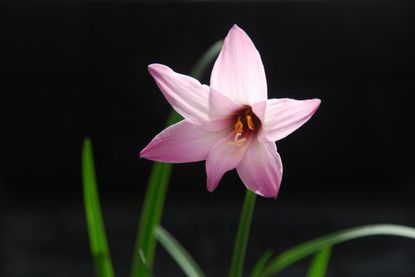Growing Rain Lilies: How To Care For Rain Lily Plants


Rain lily plants (Habranthus robustus syn. Zephyranthes robusta) grace the dappled shade garden bed or container, producing adorable blooms following rain showers. Growing rain lilies is not difficult when the right conditions are available to the plant. Rain lily bulbs produce diminutive blossoms in abundance once they're settled in the right spot.
Tips for Growing Rain Lilies
Also known as Zephyr lily and fairy lily, growing rain lilies are petite, reaching no more than a foot (30 cm.) in height and rarely getting that tall. Pink, yellow and white crocus-like flowers bloom from late spring through late summer, sometimes earlier during rainy seasons.
Multiple flowers bloom on each stem. This plant is hardy is USDA Zones 7-11. A member of the Amaryllidaceae family, tips are the same for growing rain lilies as for growing the crinum lily, the Lycoris lily and even the common indoor-grown amaryllis of the same family.
Sizes and blooms differ, but care for rain lily is similar to other members of the family. Several types of rain lilies are available in today's market. Newer hybrids come in a range of colors, and bloom time will vary by cultivar, but basically, their care is the same.
- Plant where afternoon shade is available to the plant, especially in the hottest areas.
- Care for rain lily includes regular watering, even during dormancy.
- Soil should be well-draining.
- Rain lily bulbs should not be moved until the bed is overcrowded.
- When moving rain lily bulbs, have the new planting areas prepared and move them right into their new location.
When learning how to grow rain lilies, plant them in a somewhat protected location and mulch in winter, as rain lily plants can be injured at 28 F. (-2 C.) or lower temperatures.
How to Grow Rain Lilies
Plant the small rain lily bulbs in well-draining soil during the fall season. Soil that is rich, holds moisture well, and is slightly acidic is preferable for this plant. Place bulbs about an inch deep and 3 inches (7.5 cm.) apart. When moving and transplanting rain lily bulbs, any time of year will work if the bulbs are planted quickly and watered in.
Regular watering is important to keep the grass-like foliage of rain lily lush and healthy. Foliage may die back during periods of neglect, but usually returns when watering resumes. Once they're established in their bed or container, foliage will spread and blooms multiply.
Gardening tips, videos, info and more delivered right to your inbox!
Sign up for the Gardening Know How newsletter today and receive a free download of our DIY eBook "Bring Your Garden Indoors: 13 DIY Projects For Fall And Winter".

Becca Badgett was a regular contributor to Gardening Know How for ten years. Co-author of the book How to Grow an EMERGENCY Garden, Becca specializes in succulent and cactus gardening.
-
 Elegant Exotics: 8 Beautiful Amaryllis Varieties That Will Brighten Any Holiday Display
Elegant Exotics: 8 Beautiful Amaryllis Varieties That Will Brighten Any Holiday DisplayWhether red, pink, white or variegated, the right amaryllis varieties can enhance any living space, especially during the holidays. We round up eight of the most exquisite
By Bonnie L. Grant
-
 Forage For Herbs: 7 Tasty And Safe Wild Herbs To Pick Close To Your Own Backyard
Forage For Herbs: 7 Tasty And Safe Wild Herbs To Pick Close To Your Own BackyardIn addition to growing your own herbal staples, did you know there are several wild options out there that are safe and tasty – and free? Try foraging these 7 wild herbs
By Amy Grant